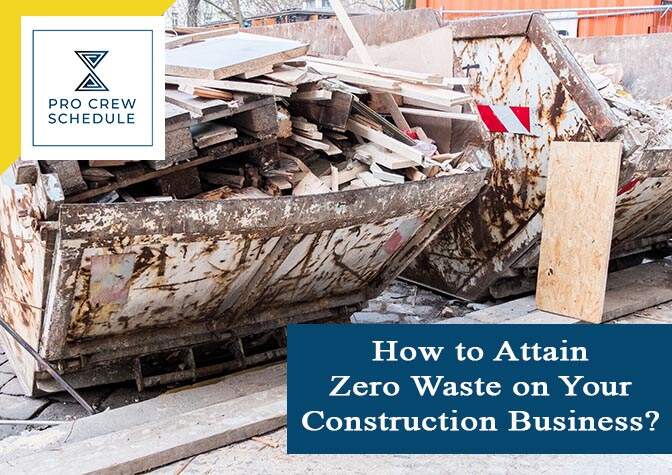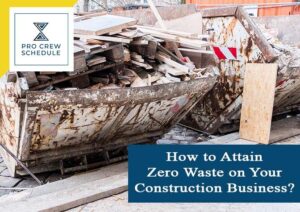Waste continues to be one of the prevalent challenges facing the construction sector and one of the most polarizing. Everybody agrees that generating less waste, reutilizing materials, as well as using more recycled content is a vital strategy for long-term economic viability and a sustainable future. How we get there and achieve it continues to be a real challenge.
And with the cost of waste disposal rising continuously each year and the green aspirations of clients, construction businesses, small and large alike, are searching for ways to reduce the amount of waste they generate. As a matter of fact, achieving Zero Waste, or at least an element or component of it, has become a popular objective for the business of all types and sizes, especially in construction.
Let’s talk about Zero Waste in this blog and let’s discover some of the best steps to achieve it for your business.
What is Zero Waste?
“Zero Waste is a simple goal that is economical, ethical, visionary and efficient, guiding people in changing practices and lifestyle to imitate sustainable natural cycles, wherein all cast-off materials are designed to become the resources for others to utilize”, stated by Zero Waste International Alliance.
By all means, zero waste refers to managing and designing processes and products to methodically eliminate and prevent the volume and toxicity of materials and waste. It aims to recover and conserve all resources without the intention of burying or burning them. Implementing Zero Waste will eradicate all waste to water, land or air that are the main threat to human, planetary, animal or plant health.
So why become Zero Waste, especially for your construction business? If you’re not yet convinced, being a zero waste in your business has many benefits. First, it can save your company the cost of waste disposal and management and regulatory complications that accompany emissions and waste generations. Second, you can actually market and brand your construction company as “Green Business”.
For sure, clients increasingly want to see solid proof of environmentally responsible business operations they support. Becoming a Zero Waste business helps you build trust with trading partners, customers and even local communities.
Steps to Achieve Zero Waste
Landfills are filling up continuously, and the construction sector is held accountable for 40% of the waste. In fact, the waste generated in the life cycle of a building, for instance, typically accounts not only for the construction but more for the phases of operations, design, and demolition.
Here are some of the best measures you can apply to achieve Zero Waste for your business.
1. Assess your company’s waste management and disposal
Auditing your current waste generation is important first when establishing a baseline to track and monitor future progress. Identify the types, volumes and sources of waste and trash generated in your business, especially on-site and determine if it’s being all placed in the right containers. Investigate if you have sufficient recycling bins or waste collection bins available and adequately put up for best results.
A professional waste audit is a very detailed analysis of waste cycle, management, as well as disposal during a specific given period. It directly involves classifying waste sources and types and sorting, collecting, weighing, and recording them. Moreover, it includes figuring out which items are being recycled and which items are going to the landfill.
Your construction company needs to develop a comprehensive understanding of the company’s waste stream to manage it effectively. Software solutions for project task management can also help you and your team as well in monitoring changes and progress. Advanced tools like this are designed to cater to your company’s unique needs.
2. Go after the Build momentum and Low-hanging fruit
Right after the waste audit, it will be already easier for you to identify what waste items you can abolish right away – the well-known “low hanging fruit”. You can discuss these things with your employees and construction teams regarding how the trashed items can be efficiently recycled, reutilized, or composted. And most importantly, you may determine some items that might put into the garbage but still can be diverted right away.
Other quick wins can also be made by implementing simple steps to lessen energy consumption like upgrading your lighting systems, switching off lights when necessary, and keeping windows and doors closed to improve heating or refrigeration efficiency further. Overall, what you and your team needs are specialized software like subcontractor scheduling software to effectively communicate and track each other’s tasks and progress, resulting in faster task completion.
3. Set specific Waste Reduction Goals
Some goals can be realized much faster than others. For instance, requesting your suppliers to convert to a reusable system to remove the generation of waste might take months to coordinate. And while also changing inputs to include remanufactured or recycled content, for instance, may take an extended timeframe to realize.
Creating a yearly or monthly goal is an excellent way to successfully ensure you’re on the right track to become Zero Waste in business. Besides, you will continuously be on the right track when you use construction scheduling software. Not only can you track your goals, you can also monitor your day-to-day operations and the crew involved.
Such measures can provide you essential feedback whenever taking corrective actions if necessary. Another great way to generate enthusiasm among your clients and employees is to have a short-term goal achievement. Having this type of goal also signals other stakeholders about your resolve when it comes to eliminating waste.
4. Engage your crew in Zero Waste Goal Attainment
After setting goals together with your team, you need now to build and follow specific strategies. And engaging your employees is one of the most crucial steps in implementing such policies. Raising and educating employee awareness in combination with providing resources and training are important steps of your company’s Zero Waste journey.
Ultimately, your perspective must also shift from waste reduction to conservation of the resource.
5. Develop Waste Reduction and Prevention Strategies
Once you have already set waste reduction goals, implement proper actions and strategies to achieve them. Waste reduction, waste prevention, and waste diversion are three of the most critical approaches. Waste prevention and reduction are two approaches that can be challenging to achieve. These approaches often require collaboration with your suppliers and probably other supply chain stakeholders.
Below are some proven waste reduction approaches you may want to implement:
Reduce carbon footprint and improve energy-efficiency
A number of steps can be taken to lessen energy consumption, like installing occupancy sensors, switching off lights and other equipment, taking steps to optimize heating and refrigeration systems, and installing microgeneration capacity or considering green energy providers. Beyond your business location, energy efficiency opportunities extend toward the greening of supply chain practices for your workers, the use of public transit, carpooling activities and other greener options.
Specify recycled content
Today, many companies are looking for ways to promote waste reduction with the utilization of natural or recycled sourced materials that can improve the overall demand for recycled construction materials—in that way, helping them establish the financial visibility of recycling whilst minimizing the need for new materials.
Take note that recycled materials can also offer cost savings over newly made materials.
Composting anaerobic absorption
Composting anaerobic absorption plays a significant role in accomplishing Zero Waste in your company. Such an approach can benefit your business when searching to divert troublesome construction waste from the trash. This emphasis can be of much greater significance for huge waste generators such as construction firms and retailing companies.
6. Specify Modular Materials
During the design development phase, make sure to determine the elements that can be standardized for repeatability. Modular grids, panels, structural systems can all be fabricated and designed efficiently with zero-waste. Identify and specify materials that are ready for easy installation as well as dismantling. Only inventory management software can help you classify all types of materials owned by your company. This software tool gives you full control of your inventory which is crucial in any operation.
And instead of utilizing glue adhesives in bonding materials, choose mechanical fixings for reutilizing components by the end of their useful life. You can choose to work with manufacturers that advocate recyclable materials. Also, off-site construction has been advised to reduce rework when it comes to cutting modular dimensions.
7. Go for Digital Fabrication
Numerous technologies and software solutions are emerging and making changes in the construction sector. BIM, for example, offers three-dimensional virtual coordination with everyone involved the consultants particularly, reducing construction blunders. The specified building items can be integrated with LCA (life-cycle assessment) on the software tool’s material information.
This is where you need to deploy digital construction processes and advanced software solutions whenever constructing parametric modules to reduce the waste from manual molding and cutting. This particular method also allows the coordination of dimensions on-site even before fabrication, making easy adjustments for installation.
While BIM has continued to be useful in your business in many ways, project management software has also managed to be extra helpful in other aspects of your business – scheduling management, crew supervision, tracking and even inventory.
Key Takeaways
Today, smaller contractors and suppliers will come under increasing pressure to apply the same measures for waste reduction. Even builders and architects will face calls and demands to design with some changes and deconstruction in mind to prevent high levels of construction waste in the future.







